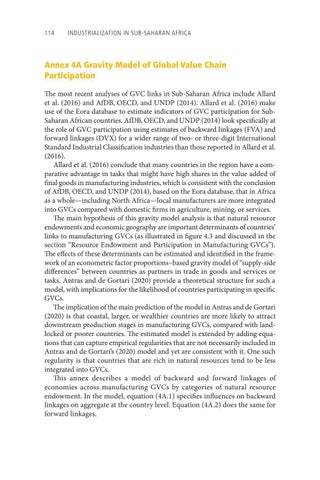114 Industrialization in Sub-Saharan Africa
Annex 4A Gravity Model of Global Value Chain Participation The most recent analyses of GVC links in Sub-Saharan Africa include Allard et al. (2016) and AfDB, OECD, and UNDP (2014). Allard et al. (2016) make use of the Eora database to estimate indicators of GVC participation for SubSaharan African countries. AfDB, OECD, and UNDP (2014) look specifically at the role of GVC participation using estimates of backward linkages (FVA) and forward linkages (DVX) for a wider range of two- or three-digit International Standard Industrial Classification industries than those reported in Allard et al. (2016). Allard et al. (2016) conclude that many countries in the region have a comparative advantage in tasks that might have high shares in the value added of final goods in manufacturing industries, which is consistent with the conclusion of AfDB, OECD, and UNDP (2014), based on the Eora database, that in Africa as a whole—including North Africa—local manufacturers are more integrated into GVCs compared with domestic firms in agriculture, mining, or services. The main hypothesis of this gravity model analysis is that natural resource endowments and economic geography are important determinants of countries’ links to manufacturing GVCs (as illustrated in figure 4.3 and discussed in the section “Resource Endowment and Participation in Manufacturing GVCs”). The effects of these determinants can be estimated and identified in the framework of an econometric factor proportions–based gravity model of “supply-side differences” between countries as partners in trade in goods and services or tasks. Antras and de Gortari (2020) provide a theoretical structure for such a model, with implications for the likelihood of countries participating in specific GVCs. The implication of the main prediction of the model in Antras and de Gortari (2020) is that coastal, larger, or wealthier countries are more likely to attract downstream production stages in manufacturing GVCs, compared with landlocked or poorer countries. The estimated model is extended by adding equations that can capture empirical regularities that are not necessarily included in Antras and de Gortari’s (2020) model and yet are consistent with it. One such regularity is that countries that are rich in natural resources tend to be less integrated into GVCs. This annex describes a model of backward and forward linkages of economies across manufacturing GVCs by categories of natural resource endowment. In the model, equation (4A.1) specifies influences on backward linkages on aggregate at the country level. Equation (4A.2) does the same for forward linkages.

